UTM links and GET parameters — how to properly track traffic
Author - Constantin Nacul
Traffic analysis is an important tool for increasing a website’s efficiency. Google Analytics 4 helps identify the source of traffic: social media, search engines, advertising, organic traffic, and so on. But to track a click more precisely — down to a specific page, link, keyword, or individual marketing campaign — UTM tags are helpful.
What are UTM tags made of?
UTM tags are snippets of code that can be added to the end of a URL. These parameters can be used with analytics platforms like Google Analytics 4 to better track user behavior after they click on a link.
Technically, the tag is added to the URL using a GET parameter. It transmits data in the URL in a “name-value” format.
Example with a UTM tag:

Where:
- utm_source, utm_medium and utm_campaign — parameters;
- netpeak, cpc and school-goods — value. The value of the UTM tags themselves tells you where the user came from.
Let’s break down another example:

From this UTM tag, we can understand that:
- The user came to the website from the Google search engine (utm_source=google);
- through the banner advertising channel, with payment per impression (utm_medium=display);
- clicked on the ad from the „coffee_maker” advertisement (utm_campaign=coffee_maker).
An interesting fact. The abbreviation UTM (Urchin Tracking Module, Urchin Traffic Monitor) includes the name of the company Urchin, which was acquired by Google in 2005. Later, it was renamed Google Analytics. Their development, the UTM tag, became the standard for web analytics.
Types of tags: mandatory and optional UTM parameters
There are mandatory and optional tags. I’ll talk about the mandatory ones.
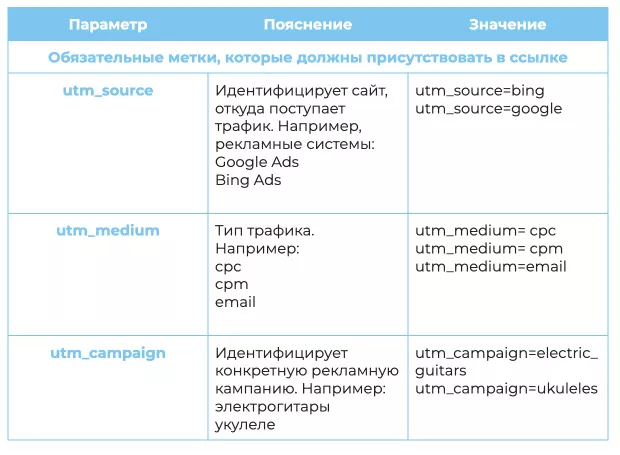
Also, in Google Analytics 4, it is necessary to use an additional parameter utm_id to measure the return on investment in campaigns that are not related to Google.
Optional parameters:

For most tracking, the basic parameters are sufficient.
The syntax of UTM tags
Try generating a UTM tag. There’s nothing complicated in its syntax:
- between the key and its value, there is the " =" sign=»;
- the parameters are separated from each other by the " & " sign&».
Let’s assume there’s a resource with a blog on different subdomains. The task is to find out how many users visited the site via an ad banner from a blog article.
The algorithm includes two steps.
- Specify the UTM name, then place the " =" sign.
- Specify the value of the parameters.
Don't forget about the main parameters of the tag:
- utm_source — source;
- utm_medium — type of advertising;
- utm_campaign — campaign name;
- utm_content — ad or clickthrough.
Form the tag.
- Write the page URL: https://yoursite.com/product/.
- Next, start forming the UTM tag by adding the "?" sign: https://yoursite.com/product/?.
- Next comes the utm_source parameter. Since you need to track traffic from the blog to the website, write: https://yoursite.com/product/?utm_source=blog.
- Add "&" to separate the next GET parameter: https://yoursite.com/product/?utm_source=blog&.
- Specify utm_medium to indicate the type of advertising. In this case, it’s a banner ad: https://yoursite.com/product/?utm_source=blog&utm_medium=banner.
- After the separator sign "&", specify the utm_campaign tag to indicate that the banner is located in the article: https://yoursite.com/product/?utm_source=blog&utm_medium=banner&utm_campaign=article.
- The utm_content tag will be useful to identify which banner performed (if there are multiple banners). And don’t forget the "&": https://yoursite.com/product/?utm_source=blog&utm_medium=banner&utm_campaign=article&utm_content=green-banner.
- Similarly, you can add other parameters, but for this example, this is enough.
The final appearance of the URL for tracking traffic from the blog article through banner advertising looks like this:
Dynamic parameters. How to simplify working with UTM tags
UTM supports two types of parameters: static and dynamic. The latter are used for automatically tagging links (advertisements) so that you don’t have to fill them in manually.
URLs with dynamic parameters make the work much easier, although they look bulkier. They also collect more detailed information: display region, keyword, position at the time of the click, etc.
Google uses its own dynamic parameters for advertising campaigns — ValueTrack.
Example of a link with dynamic parameters in Google:
Where:
- {google} — the advertising network from which the click was obtained;
- {creative} — this is the unique identifier of the ad.
- {keyword} — for the search network, it defines the keyword corresponding to the user's query; for the display network, it defines the keyword corresponding to the site content.
The analytics system accurately identifies the click source: "g" — from Google Search, "s" — from a search partner site, "d" — from the display network, etc. More parameters can be found in Google documentation about ValueTrack.
Some examples:

UTM tags and gclid in contextual advertising
You can track contextual advertising traffic in Google Ads in two ways:
- UTM tags. They are beneficial when the advertising campaign runs across multiple ad systems, as they are universal.
- The function of gclid (Google Click Identifier). The advantage of gclid is that these tags are applied automatically, and there is no need to add anything manually.
Example with UTM tags for Google Ads:
What does the markup mean:
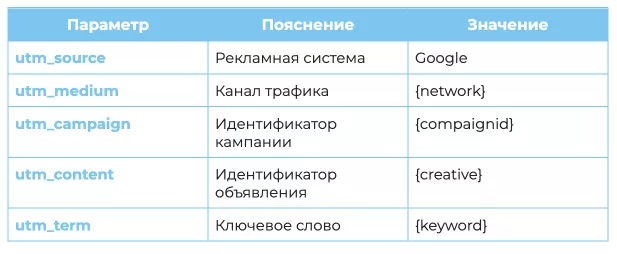
Targeted advertising
When running ads on social media, it’s important to understand which ad campaigns performed the best and brought in more users. This will help better manage the advertising budget: turning off ineffective ads and increasing the budget for more profitable campaigns.
Example with UTM tags for Facebook (Meta) Ads:

What does the markup mean:

UTM tags in email campaign
If the company uses email marketing, UTM tags will help understand which emails have the greatest impact.
Example of UTM tags for links in emails:
Meaning of the markup:
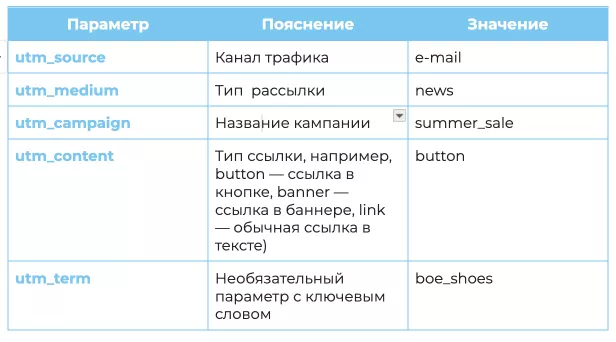
UTM tags for QR codes
UTM tags are a universal feature for tracking traffic. With their help, you can also track offline traffic, such as QR codes.
Пример URL с UTM-разметкой для QR-кодов:

What does the markup mean:
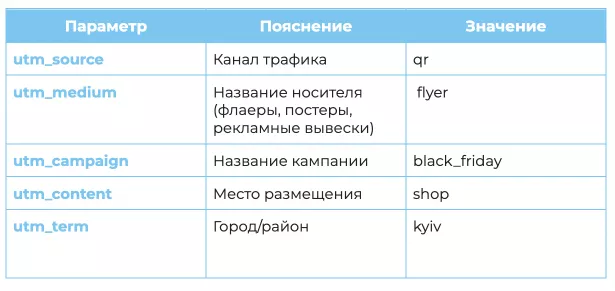
UTM tags for natural links
UTM tags can also be used to better track traffic from guest posts, mentions, and other types of natural link placements.
Example of UTM tags for a link in a guest post:

What does the markup mean:

The tagging of a link in a social media post will be slightly different:

Where:

Example of UTM tagging for a link added to an already existing article:
Where each parameter means:
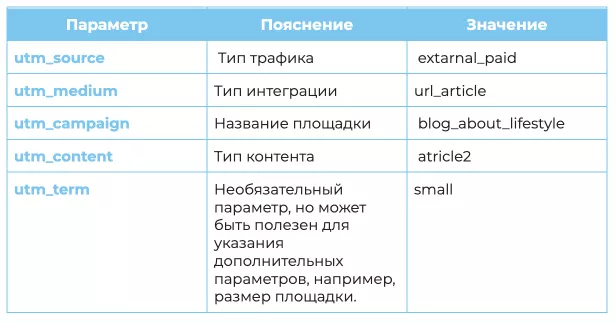
How to view UTM tag statistics in GA4
UTM tag statistics are easy to view in Google Analytics 4. To do this, follow a few steps.
- Go to the "Traffic Sources" section
- Open "Traffic Acquisition"
- In the table, select the "Source/Medium" parameter

In the report, sources are marked with the parameter utm_source, while the channels are — utm_medium. To view data for utm_campaign, select the "Campaign associated with session" parameter
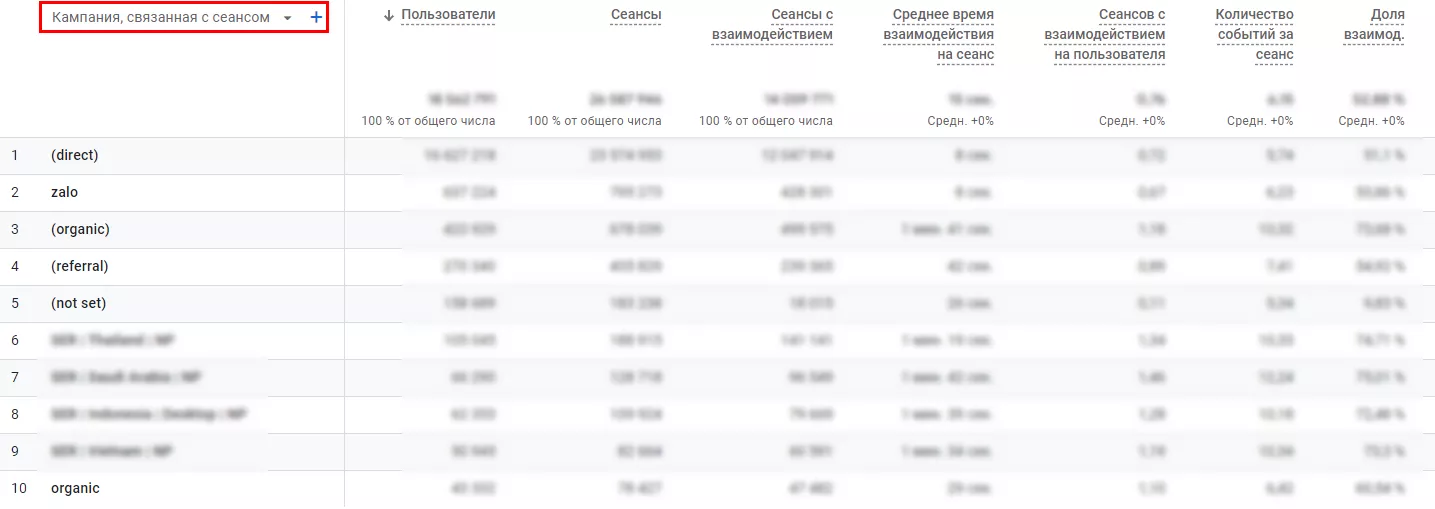
More detailed information can be found in Google Help.
How to generate UTM tags – Google’s generator and Google Sheets
Google UTM Generator
With With Google’s UTM Generator it’s very easy to use. You only need to fill in three mandatory fields in the form.
- Website URL — link to the website.
- Campaign Source — platform or traffic source, such as Facebook or email.
- Campaign Medium — type of traffic, such as CPC, social media, or QR code.
There are also optional fields.
- Campaign ID — campaign identifier.
- Campaign Name — campaign name.
- Campaign Term — mainly used for tracking keywords in Google Ads.
- Campaign Content — a useful metric for A/B testing, where you can specify additional parameters.
Example of filling out the form:
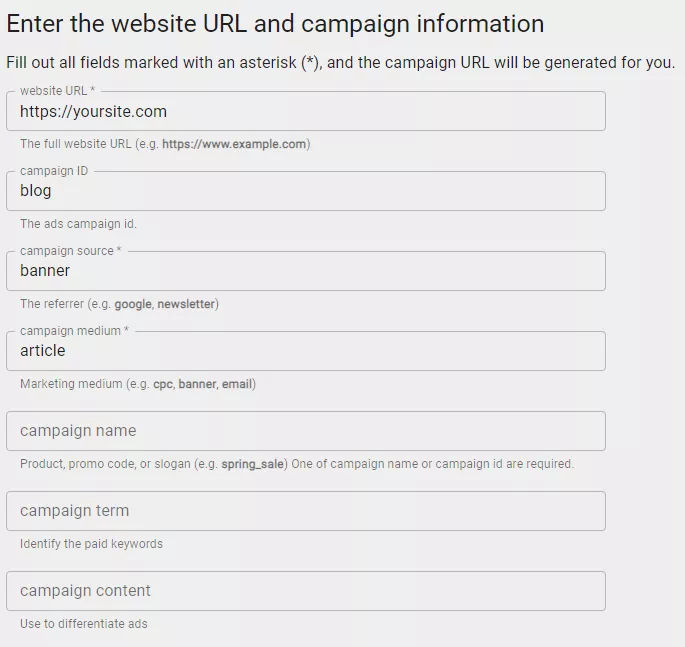
In the end, you get the link:

You can use the "SHORTEN LINK" button to shorten the link:

There are also other generators from Google, depending on where the data is collected — Google Analytics 4, Google Play, or Apple App Store. Detailed information about each of them can be found in in the Google support documentation.
Templates in Google Sheets
Another simple way — using the CONCATENATE formula to generate Template in Google SheetsEnter the URL in the template, add the required data from the list, and get the ready link:

Useful recommendations and life hacks for working with UTM
Shorten your links
To avoid making your links too bulky, use special shortening services. Here are the most popular ones:
2. Standardize the names
There are no strict rules on how UTM tags should be, you can customize them according to your needs. However, despite this flexibility, you should create your own system of rules for building tags so that you can analyze them correctly.
This is especially important for large teams where multiple people are involved in the process of creating and analyzing UTM tags. Imagine a situation where one person uses a hyphen and another uses an underscore. For the analytics system, these will be two separate links.
It is worth creating a guide for formatting UTM tags. Here are a few tips for styling them.
- Use lowercase lettersUTM tags are case-sensitive. To avoid tracking issues, always write UTM parameters in lowercase.
- Do not use spacesbecause this can cause "paid social" to appear in the analytics system as "paidsocial."
- Use consistent delimiters The underscore, hyphen, or even ignoring the separator is not essential, the important thing is to stick to a consistent method.
- Keep your UTM tags short and simple. This will make life easier for both your traffic analysis and for colleagues who weren't involved in creating the tags.
Track your UTM links in spreadsheets
The number of tracked links tends to increase. Keeping track of them in a spreadsheet will help you find them quickly and avoid duplicates. It's most convenient when the spreadsheet has columns for shortened links, full URLs, individual UTM tags, and the date the tracked links were created. You can use ready-made templates. Free templates For tracking links.
Be careful when copying links
If you mistakenly copy a link with UTM tags and paste it in the wrong place, it can create chaos in tracking traffic.
If you use UTM codes, carefully check whether the UTM parameters are present in the inserted links. This is a necessary step to ensure correct traffic analysis.
Use UTM parameters for marketing experiments
By using UTM codes, you can conduct an experiment to test a hypothesis. For example, you can determine which images perform better: product photos or pictures with real people.
To do this, post two identical publications: one with a graphic image and the other with a photo. In the section utm_content Assign the label "graphic" to one link and "photo" to the other. Soon, you'll find out which images attract more attention.
UTM Parameters for Local SEO
By using UTM parameters, you can easily assess the traffic volume driven by your Google My Business profile. Adding UTM tags to links in your Google My Business profile is a simple process.
You can track with UTM parameters links to the homepage, menu, orders, appointments, and all other sections provided to users via GMB.
Track traffic from influencers
The effectiveness of influencer collaborations can sometimes be difficult to assess, especially when comparing the effectiveness of campaigns from different sources. However, UTM parameters can help. Simply provide influencers with personalized links with UTM tags to understand which one drives more traffic and which portion of it converts.
Common mistakes in UTM tagging
Incorrect syntax
If you're setting many parameters, use tag generators to avoid mistakes.
Using only static parameters
This leads to a lot of time spent on generating tags, especially when testing identical ads or banners. Use dynamic parameters to avoid having to manually write the ID of each ad. utm_content вручную.
Duplicate pages in the index
Поисковые боты индексируют все URL, доступные на сайте, в том числе и с UTM-меткой. Используйте rel=»canonical» for the link to the page without the tag, so that duplicate URLs containing UTM won't get indexed.
Tagging internal links with UTM parameters
Tagging internal links on the site can lead to a false increase in traffic in analytics, as UTM parameters overwrite the traffic source.
For example, a user clicks on an ad link from social media, and analytics will record that. But if that user later clicks an internal link with UTM tags, the last channel and source will be overwritten with the ones specified in the UTM (this is how GA works). As a result, inaccurate data ends up in the analytics.
Используйте параметры UTM только для внешних ссылок.
5. Incorrect placement of the “#” anchor
When a link needs to lead to a specific section of the page, the “#” anchor is used. To track such a link correctly, UTM tags must be placed before this symbol.
Incorrect:

Correct:

Use these "golden rules" to make working with UTM tags easier once and for all:
- source, medium, campaign — the main parameterswhich must be filled in first;
- do not use Cyrillic characters, write all values using Latin characters;
- Case matters — identical values with different cases will appear in different rows in analytics;
- Words are always separated by a hyphen or an underscore;
- Spaces in links are prohibited;
- Check the links before publishing: copy and paste it into the browser's address bar. If the page loads, everything is fine;
- use one marking system;
- the website must support UTF-8;
- the tag must contain only one question mark (?) — at the beginning.
Итоги
- UTM tags are a useful tool for marketers, allowing them to assess the effectiveness of different advertising campaigns.
- In essence, this is a link to a resource with unique tags, placed in a specific advertising campaign, allowing you to accurately determine how many clicks it generated.
- UTM tags will help to accurately identify traffic sources on the website.
- The tag must include a parameter and its value. Three are mandatory — utm_source (traffic source), utm_medium (advertising channel), and utm_campaign (specific campaign). There are also optional parameters that, if desired, will provide even more data about the traffic.
- To automatically tag URLs with the necessary tags, use dynamic parameters. They make the link bulkier but help avoid mistakes.
- Google Ads has its own auto-tagging. You should use it if you’ve launched an ad campaign in one direction only.
- You can create tags using special generators and track the results in Google Analytics 4.
A source: NETPEAK JOURNAL

